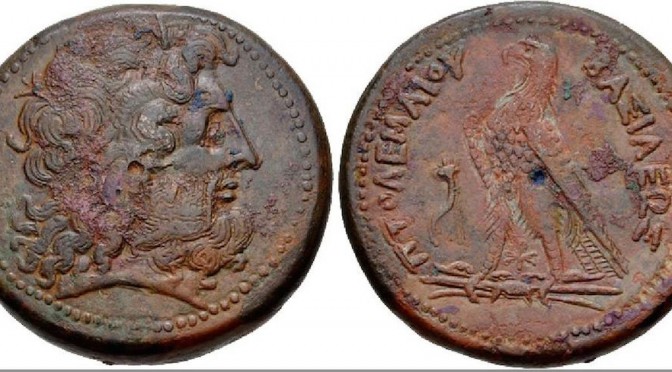The Enigma
Constantine ended the relatively short term discrimination against the Church of Rome but it was not by making it the state religion.
What he actually did was to ban discrimination against any religion. He did not expect the Church of Rome to demand supremacy and was disappointed and disillusioned by the way they reacted. He intervened to support both the Donatist and Arian heresies. He was only baptised on his death bed and he was baptised as an Arian.
Chrestos
The name of “Christian” is a real mystery . Many early Christians, including some of the Church fathers such as Justin Martyr, actually called themselves Chrestians rather than Christians. Marcionites referred not to Jesus Christ, but to Isu Chrestos. The oldest known Christian inscription, dating from 318 AD, was found over the doorway to a Marcionite Church and read, “The Lord and Saviour Jesus the Good” – the title Chrestos being used rather than Christos. According to Lactantius, another early Christian writer, “it is only through ignorance that men call themselves Christians instead of Chréstians.
The tenth century copy of the history of Tacticus was modified later to change Chrestian to Christian”The gospels were originally written in Greek, not Aramaic or Hebrew, and that is not to buy into the argument of what Jesus and his disciples spoke( probably Aramaic but possibly Greek as a second language).
The greek word for “Annointed” and therefore Messiah is “Christos” and this is probably where the name “Christians” came from. However long before Jesus birth both Mithras the Persian and Roman god and Osiris, the Egyptian god who was the husband of Isis were known as Chrestos.
There is a prophecy of the Erythrean Sybil which states, “IESOUS CHREISTOS THEOU HUIOS SOTER STAURUS”. This literally means “Iesus, Christos, God, Son, Saviour, Cross”. This is quite weird when you think that it was made by a Pagan oracle several hundred years before the birth of Jesus of Nazareth!
The title Chrestos was also used to refer to gods themselves. There is, for example, evidence that the Egyptian sun god Osiris was called Chrestos, whilst the word Chrestos can be seen on a Mithraic relief in the Vatican. Mithras was a sun god popular in Rome around the time of Jesus, many aspects of whose cult (including his birthday of 25 December) were absorbed into Roman Christianity. In this sense, the title Chrestos was linked to the god as a saviour figure or Soter.
The Good Men
By the time of Jesus, though, Chrestos had acquired an outward meaning of a kind, good or honourable man – a title that would precede a person’s name much like ‘the honourable …’ in modern English. So Jesus became the “Good Man Jesus”. Chrestos continues to mean ‘honourable, upright or virtuous’ in modern demotic Greek.
All this leads us to believe that Cathars called themselves “Good Men” and that the only link with christianity was that Jesus was a “Good Man”. This can be interpreted as meaning that Jesus shared their faith or that like Mohammedans they regarded Jesus as a special person but not God.
The Church of Rome seems to gone out of it’s way to claim that Cathars and a dozen other similar sects were all ‘Christians’, heretic but part of the Christian Community and therefore under the their judiciary. Because of variations in translation or the deliberate mistranslation, the records the Roman Church claim that the Cathars called themselves “Good Christians”.
SPQR
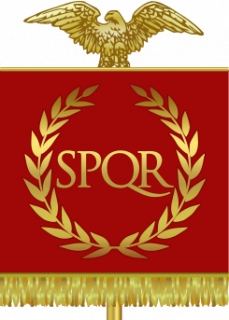 The Roman standard before the time of Constantine. SPQR is an acronym for Senatus Populusque Romanus–For the Senate and the People of Rome.The Roman standard before the time of Constantine carried the insignia SPQR, which is an acronym for Senatus Populusque Romanus–For the Senate and the People of Rome. The standard was topped by an eagle.
The Roman standard before the time of Constantine. SPQR is an acronym for Senatus Populusque Romanus–For the Senate and the People of Rome.The Roman standard before the time of Constantine carried the insignia SPQR, which is an acronym for Senatus Populusque Romanus–For the Senate and the People of Rome. The standard was topped by an eagle.
Chi Rho
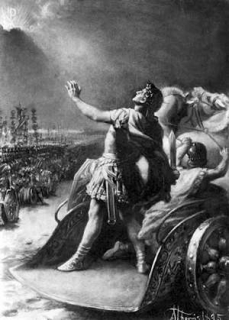
Constantine adopted the Chi Rho Symbol at the battle of Milvan bridge in 312, and he won.The Church of Rome claims that Constantine saw a vision before the battle of the Chi Rho Symbol and that Chi rho are the first letters of Christ in greek and that subsequently Constantine adopted the Christian faith.
Sol Invictus
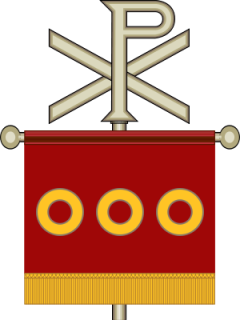 Constantine adopted the Chi Rho Symbol at the battle of Milvan bridge in 312, and he won.The Church of Rome claims that Constantine adopted the faith
Certainly Constantine changed the Roman Standard. Chi Rho replaced the eagle as a symbol. Rarely mentioned however are the three balls below which effectively replace SPQR, as a dedication. They are in fact a representation of the Sol Invictus, the Mithratic god of the Sun ,Bel god of Babylon and Ra god of Egypt.Certainly Constantine changed the Roman Standard. Chi Rho replaced the eagle as a symbol. Rarely mentioned however are the three balls below which effectively replace SPQR, as a dedication. They are in fact a representation of three visions of the same god, the Sol Invictus; the Mithratic god of the Sun , Bel god of Babylon and Ra god of Egypt.
Constantine adopted the Chi Rho Symbol at the battle of Milvan bridge in 312, and he won.The Church of Rome claims that Constantine adopted the faith
Certainly Constantine changed the Roman Standard. Chi Rho replaced the eagle as a symbol. Rarely mentioned however are the three balls below which effectively replace SPQR, as a dedication. They are in fact a representation of the Sol Invictus, the Mithratic god of the Sun ,Bel god of Babylon and Ra god of Egypt.Certainly Constantine changed the Roman Standard. Chi Rho replaced the eagle as a symbol. Rarely mentioned however are the three balls below which effectively replace SPQR, as a dedication. They are in fact a representation of three visions of the same god, the Sol Invictus; the Mithratic god of the Sun , Bel god of Babylon and Ra god of Egypt.
Sunday
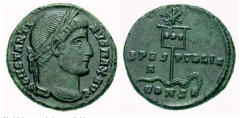 This coin, from 321 shows the labrum impaling a snake. In this year Constantine demanded that Sun day, the day of Sol Invictus, be made a day of rest. this was subsequently adopted by the Church of RomeIt wasn’t only his standard which did not comply with what the Church of Rome would like us to believe.
This coin, from 321 shows the labrum impaling a snake. In this year Constantine demanded that Sun day, the day of Sol Invictus, be made a day of rest. this was subsequently adopted by the Church of RomeIt wasn’t only his standard which did not comply with what the Church of Rome would like us to believe.
A coin from 321 shows the labrum impaling a snake. In this year Constantine demanded that Sun day, the day of Sol Invictus, be made a day of rest. This was subsequently adopted by the Church of Rome.
The Baptism
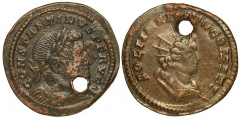 This coin was issued three years before Constantine's death If there is any doubt who is on the reverse of the coin it is spelled out " Soli Invicto Comiti"
This coin was issued three years before Constantine's death If there is any doubt who is on the reverse of the coin it is spelled out " Soli Invicto Comiti"
Another coin was issued three years before Constantine’s death. If there is any doubt who is on the reverse of the coin it is spelled out ” Soli Invicto Comiti”
It would appear that Constantine is honouring both Christian and Pagan Gods almost equally until the end of his life. Constantine was baptised as an Arian on his death bed. The Arian faith had little in common with the Church of Rome and may have predated the birth of Jesus.
From Egypt
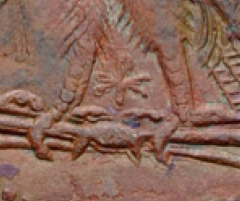 In a way it does not matter what the origins of Chi Rho are although Sir Flinders Petrie apparenty found it on several even earlier monuments. This coin proves it predates Christianity by a long period and so it throws into doubt exactly what is the meaning of the symbol on Constantine's Labrum and therefore Constantine's relationship with the Church of Rome
In a way it does not matter what the origins of Chi Rho are although Sir Flinders Petrie apparenty found it on several even earlier monuments. This coin proves it predates Christianity by a long period and so it throws into doubt exactly what is the meaning of the symbol on Constantine's Labrum and therefore Constantine's relationship with the Church of Rome
In 230 BC, over five hundred years earlier Greek teachers and students used Chi Rho in the margin of texts to indicate passages they liked. It was the first letters of Chreston meaning “good’.
At about the same time Ptolemy, Pharoh of Egypt issued a coin, on the obverse of which an eagle was strangling a snake. Between the legs of the eagle, unexplained in any way is the Chi rho symbol. In a way it does not matter what the origins of Chi Rho are although Sir Flinders Petrie apparenty found it on several even earlier monuments. This coin proves that the use of Chi Rho as a symbol predates Christianity by a long period and so it throws into doubt exactly what is the meaning of the symbol on Constantine’s Labrum and therefore Constantine’s relationship with the Church of Rome.
And of course a major city in Egypt is still known as Chi Rho though it is usually spelled as Cairo.
